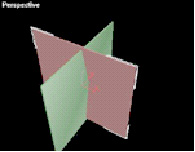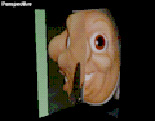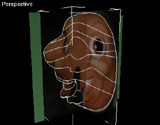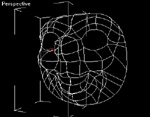|
Notice the white splines which surround the outlines of the face images. Once you have these basic outlines, draw lines which follow the contours of the face horizontally. You may wish to create a grid helper object so that you create splines in the rough position in 3D Space where they belong on the face. Then you will go into EditSpline2 and move the vertices forward and back in 3D Space until the spline follows the contour that the face does. This process involves a little artistic judgement. Use your referrence images and your own judgement to adjust the splines. One trick that Peter Watje recommends for beginners is to load a head mesh and use that as a reference. You can find head meshes 3D Café and Avalon. You will also need to adjust the Bezier tangents. For example, in the front viewport draw a line that follows the contour of the face from the nose over the eye brow and back to the end of the face. Then use a combination of the Top, Side and User views to manipulate the vertices until they create a contour line. The curve in figure 1.9 traces the contour of the face starting at the nose and following along the nose to the eye where it curves over the eye and finishes at the end of the face.
|

|
















